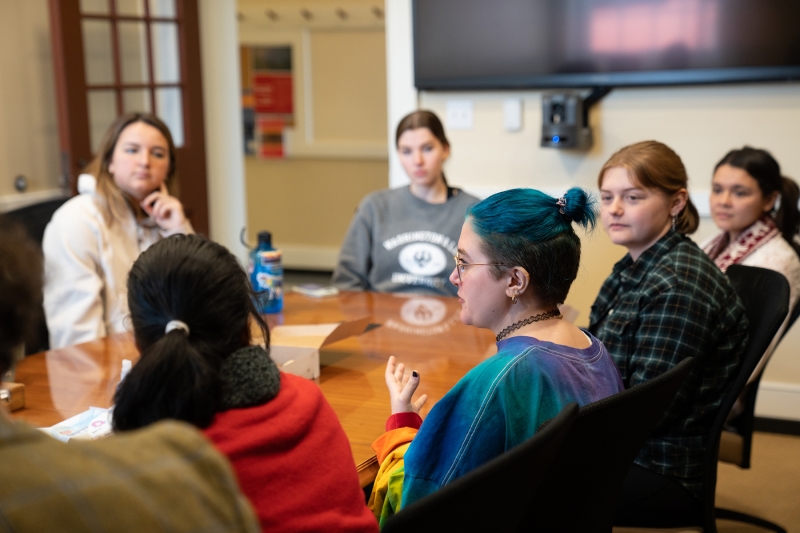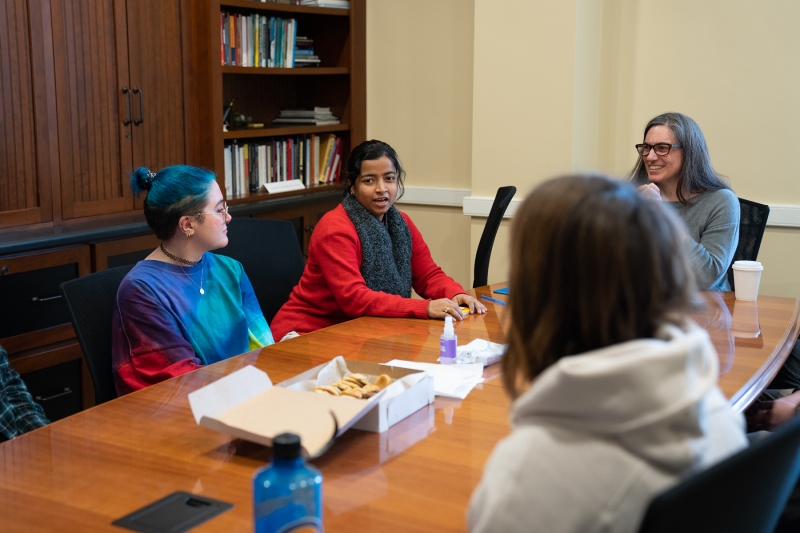CBL’s Faculty Collaborative Creates Connection Across Campus CBL’s new initiative is an opportunity for faculty development, student collaboration and deepening partnerships with the surrounding community.
“CBL courses can be incorporated into any discipline —there’s really no limit.”
~Sascha Goluboff, professor of anthropology and director of community-based learning
On Feb. 17, a small cohort of new Washington and Lee faculty gathered in Washington Hall with students for cookies and a conversation about their experiences with the Office of Community-Based Learning (CBL). Students from a variety of class years and majors arrived eager to share their work and get to know the participating faculty members, who represent various disciplines including geology, philosophy, writing, engineering, and cognitive and behavioral science.
The event was planned as part of a new CBL initiative offered to new faculty interested in engaging in high-impact teaching practices woven into community partnerships. The initiative, known as the CBL Faculty Collaborative, trains faculty and instructors on the best and most innovative practices in community-based learning, as well as provides them with critical resources and connections across campus to foster professional growth and course development. During the semester, participants design their own CBL courses or projects, examining their pedagogies, assumptions and expectations relating to community engagement throughout the process.
“We begin with having professors think about their goals and why they would be interested in working with a community partner,” said Sascha Goluboff, professor of anthropology and director of CBL.
Goluboff was inspired to create the collaborative after working on a similar, cross-university project with several other schools with support from a grant from the Associated Colleges of the South. She said that she hopes to not only break down the process of creating a meaningful and mutually beneficial community partnership through well-defined goals, but also give new faculty a cohort to share ideas and build connections across disciplines.
“It’s great how diverse the group is,” Goluboff said. “CBL courses can be incorporated into any discipline —there’s really no limit.”
During the faculty-student brainstorming session, students presented faculty with examples of past CBL coursework and projects completed with community partners, highlighting what they had learned and what they were most proud of. Students commented that having a larger goal for their coursework was impactful, as was the opportunity to apply their theoretical knowledge to actual organizations and community projects. Goluboff guided the conversation in terms of takeaways for faculty attendees. Faculty were asked to bring specific assignment drafts for the next session.
Holly Shablack, assistant professor of cognitive and behavioral science, is developing a health psychology course for Fall Term in which students will develop public health campaigns in coordination with a local organization to increase health knowledge in the broader community.
“This course will involve active communication and meetings with the community partner to identify needs and learn from their experience in terms of what actually works and doesn’t work outside of a typical research or academic setting,” said Shablack, whose research focuses on how our language and sociocultural environment impacts thoughts, feelings and behavior. “The goal is to create a mutually beneficial partnership where we learn from each other.”
She added that she has valued the opportunity to have student input as she designs her syllabus.
“We’re exploring what doesn’t work with different styles of classes, and how you can really help students engage in a reflective and active way,” Shablack said. “The ability to hear both faculty and student perspectives has been invaluable. It’s helped me think through ways to structure specific assignments, what is more feasible and realistic to achieve, the importance of communication on all ends, and the importance of flexibility and openness to unexpected changes or needs.”
Faculty are not required to teach a CBL course after participating in the collaborative. Goluboff said that the goal is more of an academic and creative exercise designed to encourage experimentation and help faculty build relationships, particularly new faculty who are increasingly eager to engage with the surrounding community.
“People are more aware now of how their own positionality affects their work,” Goluboff said. “They’re more aware of how where they’re coming from personally and professionally affects what they’re producing as scholarship, how their scholarship affects the people that read it, and the communities around them. They’re conscious of not wanting to operate in a bubble.”
 Students meet with the CBL Faculty Collaborative on Feb. 17, 2023.
Students meet with the CBL Faculty Collaborative on Feb. 17, 2023. Goluboff engages the group in a brainstorming session.
Goluboff engages the group in a brainstorming session. Madhumita Chakraborty, postdoctoral fellow in the department of earth and environmental geoscience asks students questions.
Madhumita Chakraborty, postdoctoral fellow in the department of earth and environmental geoscience asks students questions.
You must be logged in to post a comment.